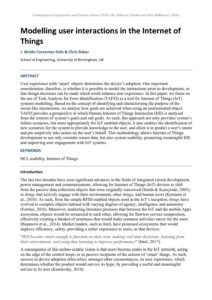| Document | Author J. Waldo Cervantes-Solis & Chris Baber |
| Abstract User experience with ‘smart’ objects determines the device’s adoption. One important consideration, therefore, is whether it is possible to model the interactions prior to development, so that design decisions can be made which could enhance user experience. In this paper, we focus on the use of Task Analysis for Error Identification (TAFEI) as a tool for Internet of Things (IoT) systems modelling. Based on the concept of identifying and characterising the purpose of the social-like interactions, we analyse how goals are achieved when using an instrumented object. TAFEI provides a perspective in which Human-Internet of Things Interaction (HII) is analysed from the context of system’s goals and sub goals. As such, this approach not only provides system’s failure scenarios, but more appropriately for IoT enabled objects, it also enables the identification of new scenarios for the system to provide knowledge to the user, and allow it to predict a user’s intent and pre-emptively take action on the user’s behalf. This methodology allows Internet of Things development to not only consider sensor data, but also system usability, promoting meaningful HII, and improving user engagement with IoT systems. |

